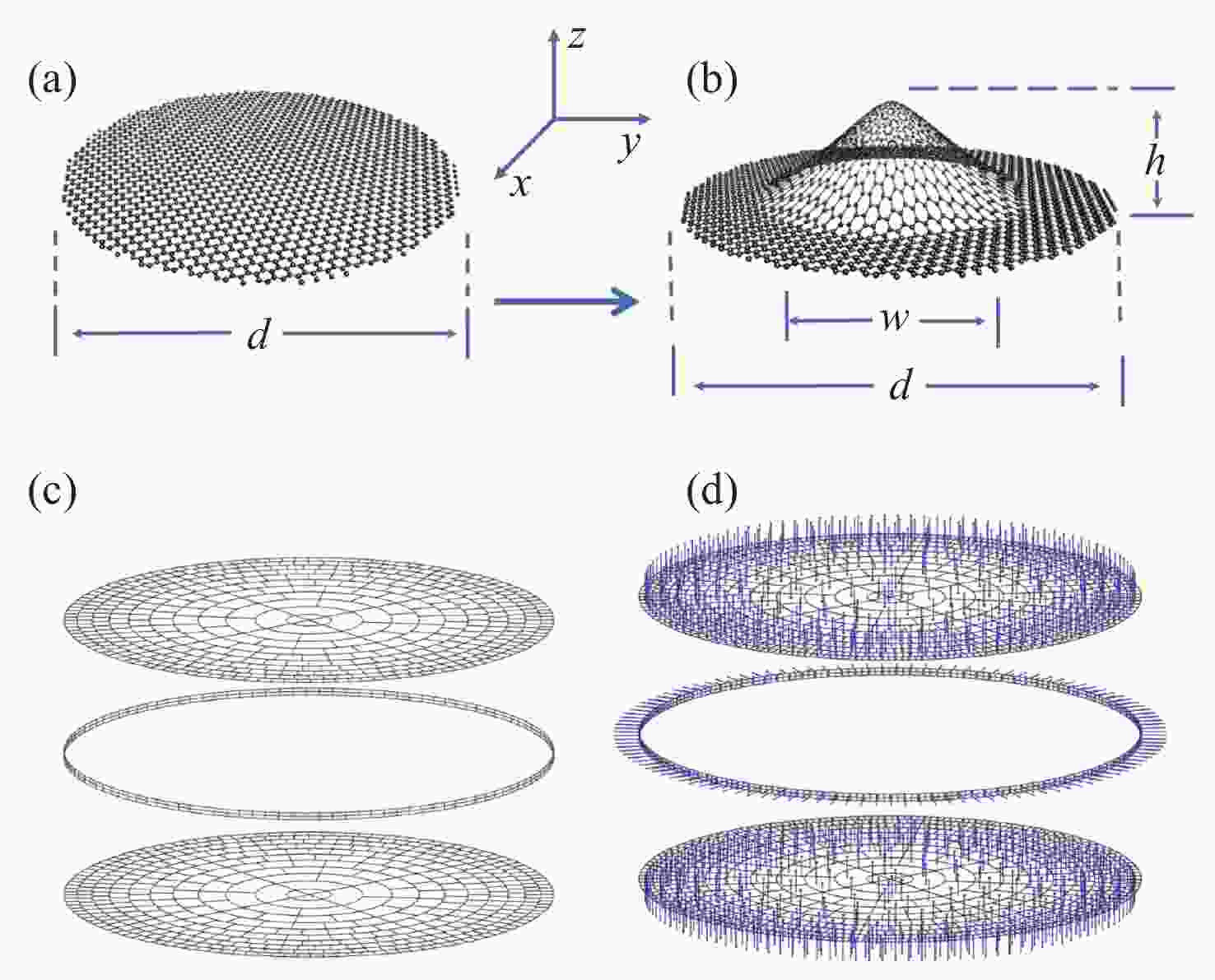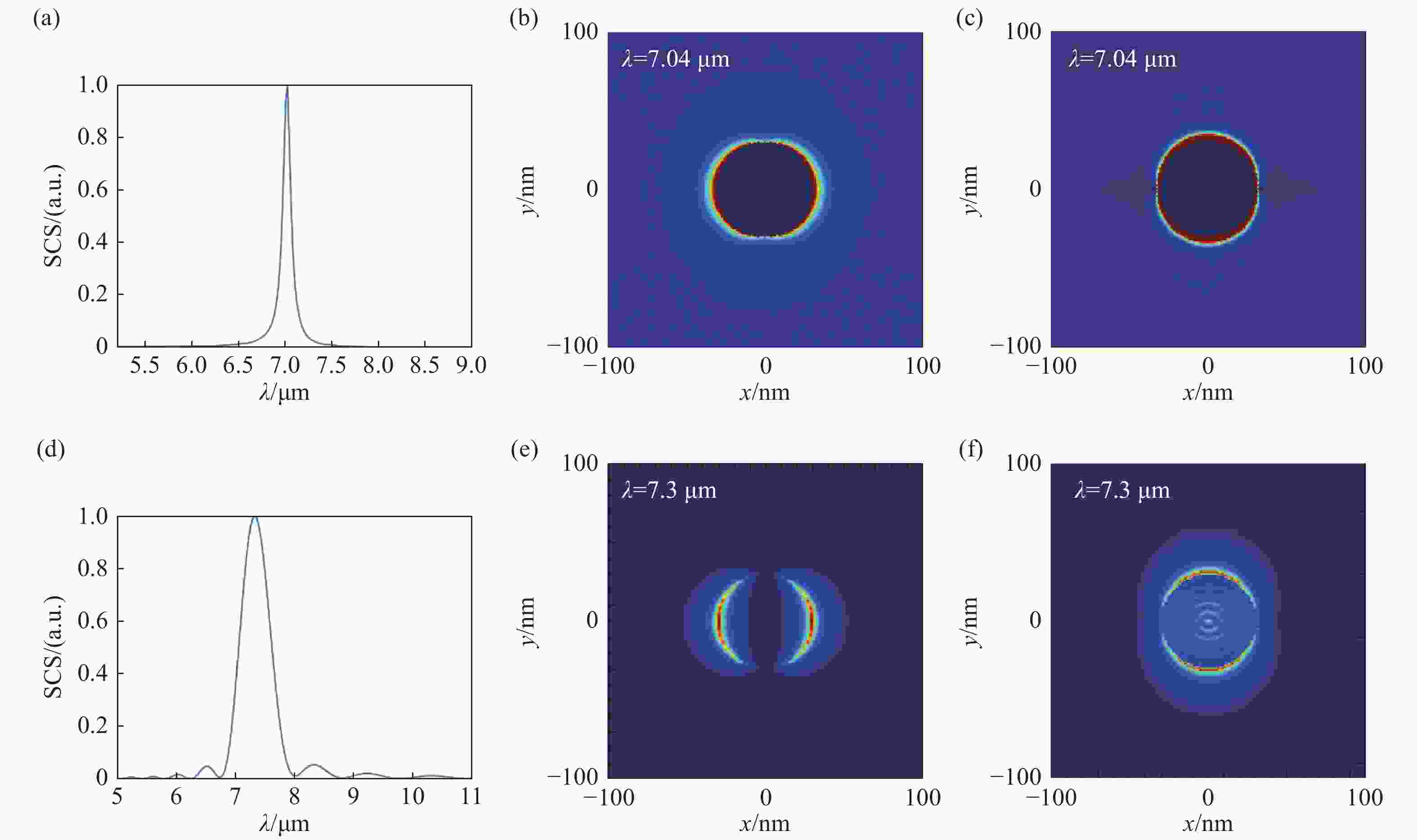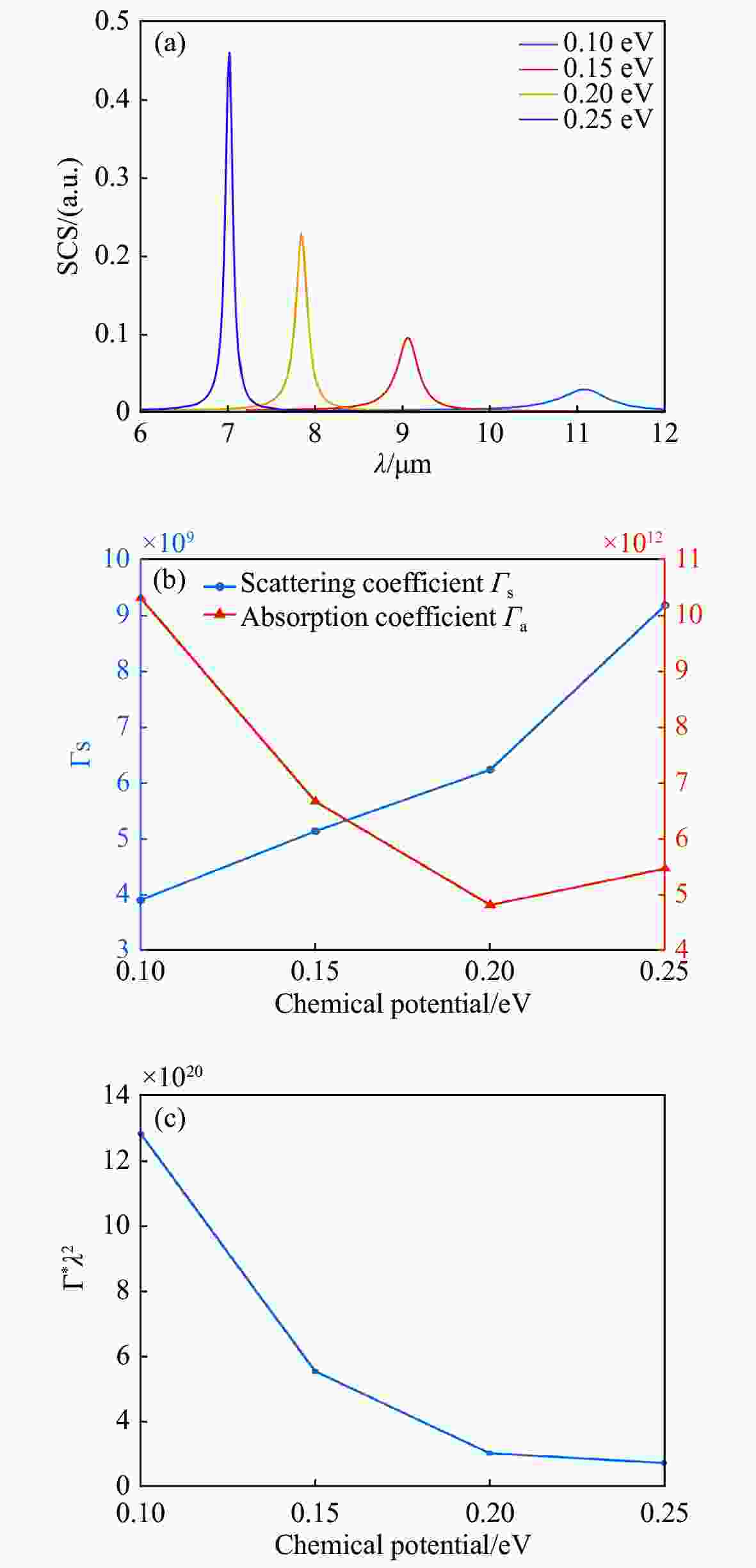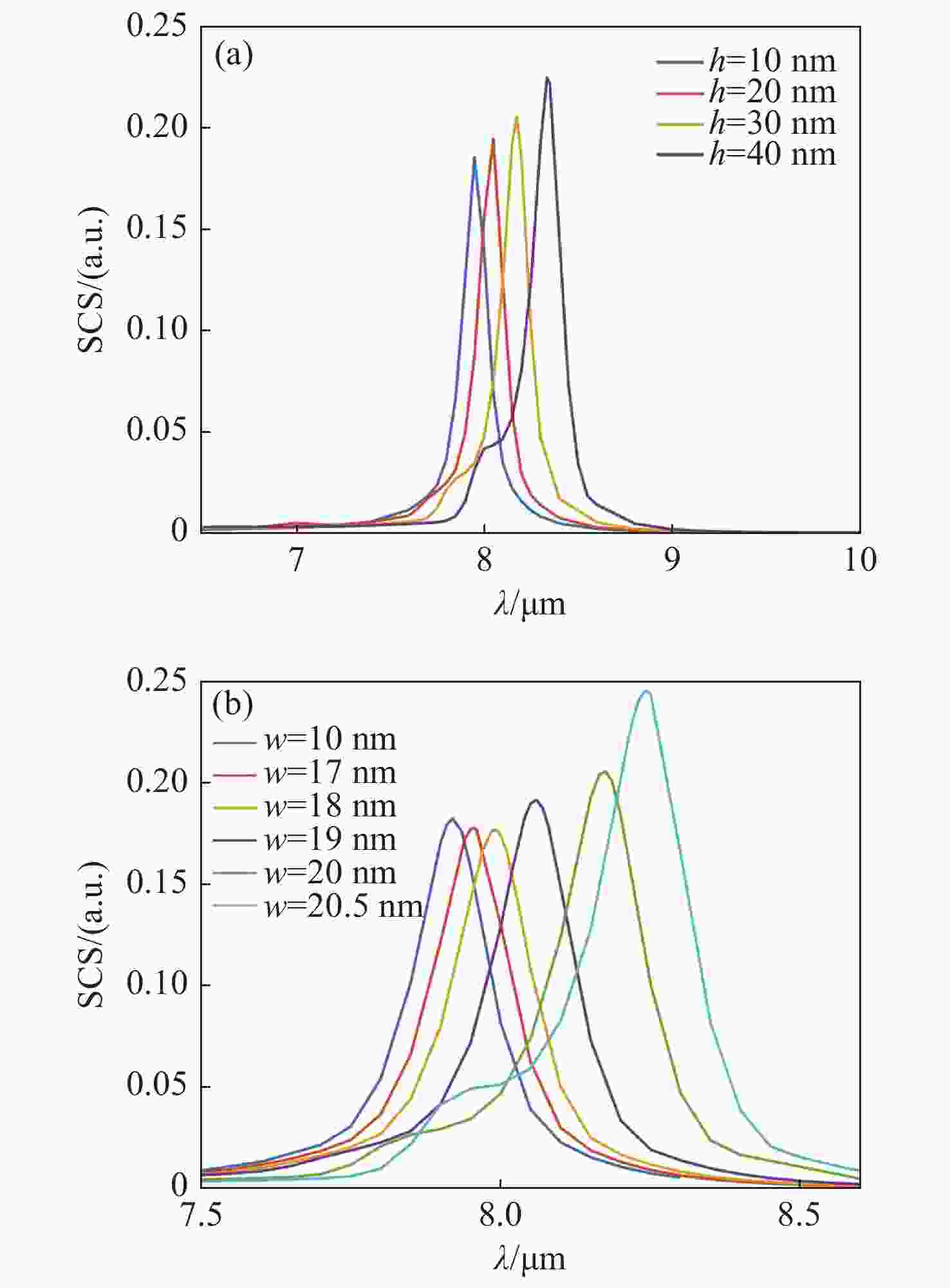Surface plasmon resonance characteristics of a graphene nano-disk based on three-dimensional boundary element method
doi: 10.37188/CO.2021-0004
-
摘要: 相对于有限元、有限时域差分等常用的仿真算法,边界元算法具有精度高、占用内存少、善于处理复杂结构的优点。本文给出了三维边界元算法的基本原理,编写了基于C++语言的三维边界元算法程序,并用其研究了石墨烯纳米圆盘结构的表面等离子体共振特性;计算了石墨烯纳米圆盘在不同化学势下的散射截面谱线及共振波长下电磁场分布等物理量,分析了石墨烯纳米圆盘在红外波段的电磁响应性质。考虑到加工过程中产生的缺陷会导致石墨烯材料出现褶皱,故又研究了石墨烯纳米圆盘中心处产生凸起后,凸起结构的几何参数对共振强度、波长等参量的影响,并采用电荷运动的弹簧振子模型对仿真结果进行了解释。Abstract: Compared with the commonly used simulation algorithms such as Finite Element Method (FEM) and Finite-Difference Time-Domain (FDTD) method, the Boundary Element Method (BEM) has the advantages of high accuracy, small memory consumption, and ability to deal with complex structures. In this paper, the basic principle of three-dimensional BEM is given, the corresponding program based on C++ language is written, and the Surface Plasmon Resonance (SPR) characteristics of a graphene nano-disk structure are studied. The Scattering Cross-Section (SCS) spectral lines of a graphene nano-disk under different chemical potentials, as well as the distributions of electromagnetic fields at the resonance wavelengths are calculated. The electromagnetic response of the graphene nano-disk in the infrared band is analyzed. In addition, considering the common corrugations of graphene materials caused by defects during processing, we study the influence of the geometric parameters of a convex structure in the center of the graphene nano-disk on the resonance intensity, wavelength and field distributions. A spring oscillator model of charge movement is used to explain the simulation results.
-
图 2 石墨烯模型以及面元划分方法(a)石墨烯圆盘模型;(b)凸起石墨烯圆盘模型;(c)石墨烯圆盘建模的网格划分;(d)石墨烯圆盘所建网格的外法向矢量(蓝色箭头所示,见网络彩图)
Figure 2. Graphene model and surface-element division method (a) Graphene nanodisk model; (b) convex graphene nanodisk model; (c) mesh generation of graphene nanodisk model; (d) outer normal vectors of the meshes generated in graphene nanodisk (shown by blue arrows)
图 4 边界元算法与有限时域差分算法结果对比图。(a)边界元获得的SCS谱线;(b)共振波长下边界元获得的磁场分布;(c)共振波长下边界元获得的电场分布;(d)有限时域差分获得的SCS谱线;(e)共振波长下有限时域差分获得的磁场分布;(f)共振波长下有限时域差分获得的电场分布
Figure 4. Comparison of the results from BEM and FDTD. (a) SCS spectrum obtained by BEM; (b) magnetic field distribution obtained by BEM under the resonance wavelength; (c) electric field distribution obtained by BEM under the resonance wavelength; (d) SCS spectrum obtained by FDTD; (e) magnetic field distribution obtained by FDTD under the resonance wavelength; (f) electric field distribution obtained by FDTD under the resonance wavelength
表 1 Parameters of mesh generation on the upper and lower surfaces of graphene nanodisk
Table 1. Parameters of mesh generation on the upper and lower surfaces of graphene nanodisk
Ring i 1 2 3 4 5 6 7 8 9 10 11 Ring width/nm 2.75 3.85 3.6 3.35 3.1 2.85 2.6 2.35 2.1 1.85 1.6 Number of surface elements per ring 4 4 8 16 24 36 48 64 80 96 116 -
[1] WANG B, WANG G P. Simulations of nanoscale interferometer and array focusing by metal heterowaveguides[J]. Optics Express, 2005, 13(26): 10558-10563. doi: 10.1364/OPEX.13.010558 [2] LI B, HU B, YANG Y L, et al. Demagnification imaging improved by mask in a hyperlens photolithography system[J]. Plasmonics, 2007, 12(3): 735-741. [3] EL-SAYED I H, HUANG X H, EL-SAYED M A. Surface plasmon resonance scattering and absorption of anti-EGFR antibody conjugated gold nanoparticles in cancer diagnostics: applications in oral cancer[J]. Nano Letters, 2005, 5(5): 829-834. doi: 10.1021/nl050074e [4] ATWATER H A, POLMAN A. Plasmonics for improved photovoltaic devices[J]. Nature Materials, 2010, 9(3): 205-213. doi: 10.1038/nmat2629 [5] ZIJLSTRA P, CHON J W M, GU M. Five-dimensional optical recording mediated by surface plasmons in gold nanorods[J]. Nature, 2009, 459(7245): 410-413. doi: 10.1038/nature08053 [6] CHEN ZH X, WANG W B, LIANG CH, et al. Progress on two-dimensional quantum sheets and their optics[J]. Chinese Optics, 2021, 14(1): 1-17. (in Chinese) doi: 10.37188/CO.2020-0060 [7] CHRISTENSEN J, MANJAVACAS A, THONGRATTANASIRI S, et al. Graphene plasmon waveguiding and hybridization in individual and paired nanoribbons[J]. ACS Nano, 2012, 6(1): 431-440. doi: 10.1021/nn2037626 [8] LIU P H, ZHANG X ZH, MA Z H, et al. Surface Plasmon modes in graphene wedge and groove waveguides[J]. Optics Express, 2013, 21(26): 32432-32440. doi: 10.1364/OE.21.032432 [9] HE X Y, LIU F, LIN F T, et al. Tunable 3D Dirac-semimetals supported mid-IR hybrid plasmonic waveguides[J]. Optics Letters, 2021, 46(3): 472-475. doi: 10.1364/OL.415187 [10] WU L, CHU H S, KOH W S, et al. Highly sensitive graphene biosensors based on surface Plasmon resonance[J]. Optics Express, 2010, 18(14): 14395-14400. doi: 10.1364/OE.18.014395 [11] PENG J L, ZHU ZH H, ZHANG J F, et al. Tunable terahertz half-wave plate based on hybridization effect in coupled graphene nanodisks[J]. Applied Physics Express, 2016, 9(5): 055102. doi: 10.7567/APEX.9.055102 [12] HE X Y. Tunable terahertz graphene metamaterials[J]. Carbon, 2015, 82: 229-237. doi: 10.1016/j.carbon.2014.10.066 [13] PENG J, HE X Y, SHI CH Y Y, et al. Investigation of graphene supported terahertz elliptical metamaterials[J]. Physica E:Low-Dimensional Systems and Nanostructures, 2020, 124: 114309. doi: 10.1016/j.physe.2020.114309 [14] TIAN H J, LIU Q L, YUE H, et al. Hybrid graphene/n-GaAs photodiodes with high specific detectivity and high speed[J]. Chinese Optics, 2021, 14(1): 206-212. (in Chinese) doi: 10.37188/CO.2020-0153 [15] CONG C X, YU T, NI Z H, et al. Fabrication of graphene nanodisk arrays using nanosphere lithography[J]. J. Phys. Chem. C, 2009, 113(16): 6529-6532. doi: 10.1021/jp900011s [16] THONGRATTANASIRI S, KOPPENS F H L, DE ABAJO F J G. Complete optical absorption in periodically patterned graphene[J]. Physical Review Letters, 2012, 108: 047401. doi: 10.1103/PhysRevLett.108.047401 [17] FANG ZH Y, WANG Y M, SCHLATHER A E, et al. Active tunable absorption enhancement with graphene nanodisk arrays[J]. Nano Letters, 2014, 14(1): 299-304. doi: 10.1021/nl404042h [18] YAN H G, XIA F N, LI ZH Q, et al. Plasmonics of coupled graphene micro-structures[J]. New Journal of Physics, 2012, 14: 125001. doi: 10.1088/1367-2630/14/12/125001 [19] ZUNDEL L, MANJAVACAS A. Spatially resolved optical sensing using graphene nanodisk arrays[J]. ACS Photonics, 2017, 4(7): 1831-1838. [20] KARANIKOLAS V D, MAROCICO C A, BRADLEY A L. Tunable and long-range energy transfer efficiency through a graphene nanodisk[J]. Physical Review B, 2016, 93: 035426. doi: 10.1103/PhysRevB.93.035426 [21] DENG SH K, BERRY V. Wrinkled, rippled and crumpled graphene: an overview of formation mechanism, electronic properties, and applications[J]. Materials Today, 2016, 19(4): 197-212. doi: 10.1016/j.mattod.2015.10.002 [22] DU ZH Y. Study of enhanced localized surface plasmonic resonance of graphene nano-ribbons[D]. Beijing: Beijing Institute of Technology, 2019. (in Chinese) [23] WANG W H, LI B H, STASSEN E, et al. Localized surface plasmons in vibrating graphene nanodisks[J]. Nanoscale, 2016, 8(6): 3809-3815. doi: 10.1039/C5NR08812G [24] SLIPCHENKO T M, NESTEROV M L, HILLENBRAND R, et al. Graphene plasmon reflection by corrugations[J]. ACS Photonics, 2017, 4(12): 3081-3088. doi: 10.1021/acsphotonics.7b00656 [25] XIA SH X, ZHAI X, WANG L L, et al. Dynamically tunable plasmonically induced transparency in sinusoidally curved and planar graphene layers[J]. Optics Express, 2016, 24(16): 17886-17899. doi: 10.1364/OE.24.017886 [26] WANG L, LIU X, ZANG J F. Mechanically tunable terahertz graphene plasmonics using soft metasurface[J]. 2D Materials, 2016, 3(4): 041007. doi: 10.1088/2053-1583/3/4/041007 [27] LIU P. Optical coupling properties of metallic nanoparticles studied by 3D boundary element method[D]. Beijing: Beijing Institute of Technology, 2013. (in Chinese) [28] WANG CH Q. Computational Advanced Electromagnetics[M]. Beijing: Peking University Press, 2005. (in Chinese) [29] CHANG F K. The investigation of nano-optical elements by 3D boundary element method[D]. Beijing: Beijing Jiaotong University, 2008. (in Chinese) [30] LIU P, LIU J, LIU J, et al. Scattering properties of an individual metallic nano-spheroid by the incident polarized light wave[J]. Optics Communications, 2011, 284(4): 1076-1081. doi: 10.1016/j.optcom.2010.10.033 [31] LIU P H. Investigation on the plasmonics of graphene microstructures[D]. Tianjin: Nankai University, 2014. (in Chinese) [32] DU ZH Y, HU B, LIU W G, et al. Plasmonic resonance of distorted graphene nano-ribbon analyzed by boundary element method[J]. Optics Express, 2018, 26(20): 25962-25973. doi: 10.1364/OE.26.025962 [33] WANG B, ZHANG X, GARCÍA-VIDAL F J, et al. Strong coupling of surface Plasmon polaritons in monolayer graphene sheet arrays[J]. Physical Review Letters, 2012, 109: 073901. doi: 10.1103/PhysRevLett.109.073901 [34] KATS M A, YU N F, GENEVET P, et al. Effect of radiation damping on the spectral response of plasmonic components[J]. Optics Express, 2011, 19(22): 21748-21753. doi: 10.1364/OE.19.021748 -





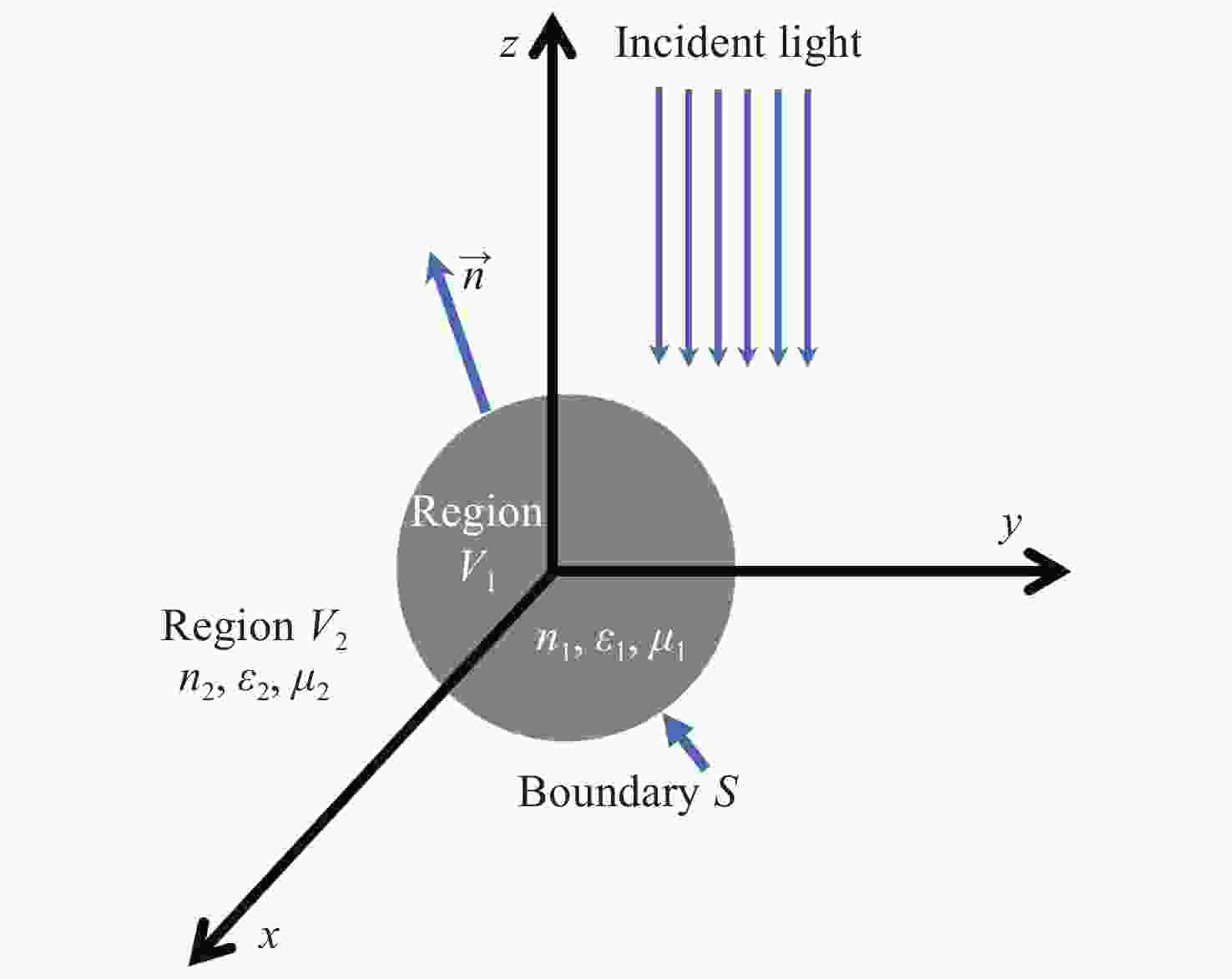
 下载:
下载:
